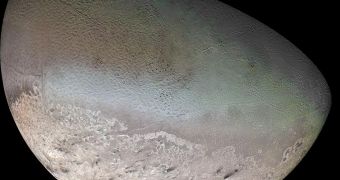Now, we consider that the outer solar system lies somewhere beyond the orbit of the planet Neptune, meaning for example the Kuiper belt, thought to be the source of the short-period orbit comets, and the Oort cloud lying more than one light year away from the Sun, which could probably be the location where long-period orbit comets originate. Although the Oort cloud hasn't been detected yet, and mostly remains a theoretical concept, the Kuiper belt is relatively visible from our perspective.
Incredible as it may seem, light spectroscopy techniques reveal a wide range of 'colors' emitted from the Kuiper belt, suggesting a homogeneous chemical element distribution. This is quite strange, taking into consideration the fact that most of the objects and planetoids in the solar system emit light in a relative short spectrum. To account for the rich element composition observed in the Kuiper belt, astronomers previously proposed that this is due to increased volcanic activity, but this is mostly impossible since the objects observed in that region of space are too small to present such a feature, no larger than 100 kilometer in diameter.
Alternatively, David Jewitt from the University of Hawaii, suggested that this effect could be produced by background cosmic rays filtering through the matter in the belt, giving it a redder aspect, while collisions between objects inside it may produce a spectrum shifted more towards the blue wavelengths of light. Nevertheless, the explanation remains mostly elusive as Jewitt's theory cannot be tested yet.
Observations on the matter present inside the Kuiper belt seem to imply the existence of some kind of material called 'ultra-red matter' that composes about half of the objects, known to be icy planetoids that were ejected from the belt relatively recently, and were trapped in an orbit between the planets Jupiter and Neptune. Even so, such objects do not exist in the inner regions of the solar system, not even when comets or planetoids come in the close proximity of the Sun, suggesting that this matter is somehow sensitive to high temperatures.
Emissions shifted towards the red spectrum of the light wavelengths are usually associated with the presence of organic materials that are though to be widely spread in comets and planetoid objects which could have brought them to Earth from the remote regions of the solar system. According to Jewitt, such organic molecules could have been altered by the action of the solar wind and cosmic rays, in a way that would give them a dark-red surface color.
Another mystery regarding the outer solar system, and especially the Kuiper belt, consists in calculations' revealing that there should be more matter present there. Jewitt argues that about 99 percent of the original matter has been dissipated, but the actual process that contributed to such an effect and the time scale needed for it to take place are unknown.
Similar to the theory that suggest that Neptune and Uranus might have switched orbits somewhere in the early life of the solar system, astrophysicists proposed that Saturn and Jupiter did the same about 4 billion years ago, altering the gravitational field acting on the Kuiper belt, which determined collisions between most objects that pulverized them and the material got swept be solar wind. However, the possibility that four giant planets switched orbits in the past of the solar system, and that the Kuiper belt got pulverized, is extremely remote, thus there are greater chances that scientists are interpreting the situation wrongly or missing some crucial aspects.

 14 DAY TRIAL //
14 DAY TRIAL //